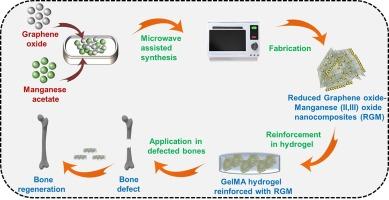Harnessing potential of microwave-assisted ultrafast synthesis of reduced graphene oxide/Mn3O4 bioactive nanocomposite hydrogel for bone tissue engineering
IF 5.8
2区 化学
Q1 POLYMER SCIENCE
引用次数: 0
Abstract
The development of functional materials with the potential for bone tissue regeneration along with rapid synthesis and cost-effective approach has been challenging. In this regard, hydrogels have been explored as a potent candidate to behave as a 3D scaffold for bone repair. However, poor mechanical attributes impeded their clinical translation. Enthralling demonstration of the potential of carbon-based nanocomposites in bone tissue engineering has been constantly encouraging the fabrication of advanced nanocomposites. Here, we investigated the fabrication of reduced graphene/manganese (II, III) oxide (RGO/Mn3O4) nanocomposites by taking advantage of the microwave-assisted synthesis approach for cost effective, and ultrafast synthesis. Mn3O4 nanoparticles with uniform distribution in RGO sheets and ∼ 1.7 nm size was fabricated using the approach. Further, fine-tuning of the structural interaction and mechanical behavior of the GelMA-based hydrogels upon reinforcement with RGO/Mn3O4 nanocomposites was investigated as a function of different concentrations of the nanocomposites where upto 50 % increment in the compressive stress was observed compared to native GelMA hydrogel. The ability of these hydrogels was further investigated for their osteogenic behaviour on MC3T3-E1 preosteoblast cells where constant cell proliferation for up to 10 days was witnessed for the hybrid hydrogel with the highest concentration of the nanofillers.

发挥微波辅助超快合成还原氧化石墨烯/Mn3O4 生物活性纳米复合水凝胶在骨组织工程中的潜力
开发具有骨组织再生潜力的功能性材料,并采用快速合成和具有成本效益的方法,一直是一项挑战。在这方面,水凝胶作为一种有效的候选材料,已被探索用作骨修复的三维支架。然而,较差的机械属性阻碍了它们的临床应用。碳基纳米复合材料在骨组织工程中的潜力得到了令人振奋的证明,这不断激励着人们制造先进的纳米复合材料。在此,我们研究了还原石墨烯/锰(II、III)氧化物(RGO/Mn3O4)纳米复合材料的制备方法,该方法利用微波辅助合成,成本低、合成速度快。利用这种方法制备出了在 RGO 片材中均匀分布的 Mn3O4 纳米粒子,其尺寸为 1.7 纳米。此外,还研究了用 RGO/Mn3O4 纳米复合材料增强 GelMA 基水凝胶后,其结构相互作用和机械行为的微调,并将其作为不同浓度纳米复合材料的函数,观察到与原生 GelMA 水凝胶相比,压缩应力增加了 50%。进一步研究了这些水凝胶对 MC3T3-E1 前成骨细胞的成骨能力,结果表明,纳米填料浓度最高的混合水凝胶的细胞增殖持续时间长达 10 天。
本文章由计算机程序翻译,如有差异,请以英文原文为准。
求助全文
约1分钟内获得全文
求助全文
来源期刊

European Polymer Journal
化学-高分子科学
CiteScore
9.90
自引率
10.00%
发文量
691
审稿时长
23 days
期刊介绍:
European Polymer Journal is dedicated to publishing work on fundamental and applied polymer chemistry and macromolecular materials. The journal covers all aspects of polymer synthesis, including polymerization mechanisms and chemical functional transformations, with a focus on novel polymers and the relationships between molecular structure and polymer properties. In addition, we welcome submissions on bio-based or renewable polymers, stimuli-responsive systems and polymer bio-hybrids. European Polymer Journal also publishes research on the biomedical application of polymers, including drug delivery and regenerative medicine. The main scope is covered but not limited to the following core research areas:
Polymer synthesis and functionalization
• Novel synthetic routes for polymerization, functional modification, controlled/living polymerization and precision polymers.
Stimuli-responsive polymers
• Including shape memory and self-healing polymers.
Supramolecular polymers and self-assembly
• Molecular recognition and higher order polymer structures.
Renewable and sustainable polymers
• Bio-based, biodegradable and anti-microbial polymers and polymeric bio-nanocomposites.
Polymers at interfaces and surfaces
• Chemistry and engineering of surfaces with biological relevance, including patterning, antifouling polymers and polymers for membrane applications.
Biomedical applications and nanomedicine
• Polymers for regenerative medicine, drug delivery molecular release and gene therapy
The scope of European Polymer Journal no longer includes Polymer Physics.
 求助内容:
求助内容: 应助结果提醒方式:
应助结果提醒方式:


